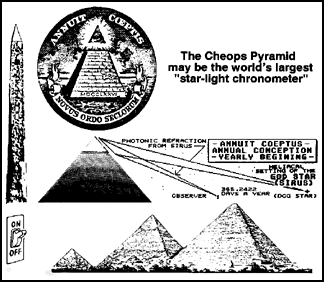spiritofatlantis.com | Duane K. McCullough

Pyramidal Star Clocks.
The building of the Cheops Pyramid is dated to about 2550 years before Christ - however, because of a new understanding of
Biblical history and the lunar time-count of the Judaic Calendar, the pyramid project could have been built only about 2550
Hellenic months before Christ - or about 210 years before.
The nearby city of ON, east of the Nile and about twenty miles north of Memphis, is also called Heliopolis. It was the center of
SUN WORSHIP for priest. This word appears just above many light-switches and is identified with the act of connecting with
energy.
V3
Chapter 6: Pyramidal Star Clocks
1/ There exists a scientific rumor that the initial layout of
the limestone pyramid project near Cairo was much more than an
elaborate burial tomb for Egyptian pharaohs.
(The photolytic swords, mentioned in the previous chapter, could
have been helpful in splitting nearby layered limestone into
useful "rock blocks" for the pyramids near Cairo)
2/ Recent surveys of the project have revealed a geometrical
system of angles by which there may have been an attempt by the
builders to redirect and "precipitate" photokinetic
solar energy into serving the public as a "star-light
chronometer".
3/ In other words, each of the three main pyramids at the
complex were progressive attempts to build "star
clocks" by which the tops of the stone structures would
photometrically "deflect" sunlight or starlight off
their sides in such a way as to visually mark when a new day or a
new year had begun.
4/ This deflection technique was enhanced by a specially
prepared "refractive stone surface" which increased the
photogenic registration so that even Sirius - the second
brightest star in the sky, would photometrically yield to the
observer when to begin the new year.
(Annuit Coeptis - the Latin statement found on the back of the
U.S. dollar, together with the pyramid illustration of the
"eye of God", translates into: "Annual
Conception" - or the "yearly beginning")
[Year = raey = ray of sunlight]
5/ Imagine long ago the starlight from Sirius, also known as
the "dog" star, annually illuminating the top half of
the Cheops Pyramid!
(The "dog" star title of the constellation Canis Major
may be linked to the three-lettered word title of the eternal
time keeper of the heavens known theologically as
"God". because the orthographic sound of "Ca"
as in "Canis" (meaning "dog" in Latin), and
the phonogramic sound of "Ki" - as in "king"
(meaning "lord" in Old English) were once synonymous)
[G = gyro gravity symbol, O = orb or sun shape symbol, D = half
circle = delta ratio = golden section]
6/ In so far as the daily registration of the sun's rays with
respect to the Cheops Pyramid complex, there is a photoelectric
phenomenon known among professional astronomers and aircraft
pilots as the "green flash" - whereby a
"spark" or "ray of sunlight" at sunset or
sunrise was "prismatically caught" by the pyramid top
in order to mark the beginning or ending of a solar day.
(The concept of pyramidal "star clocks" can also be
applied to the tops of stone monuments known as "obelisk
pillars")
[The photoelectric phenomenon of the "green flash" may
be the result of solar photons reacting with the Earth's
semi-transparent ozone layer in such a way as to transmit
photokinetic energy into an electrovalent "wave" of
oscillating molecular crystal oxygen particles, which in turn
sweep across the horizon faster than the speed of sound]
7/ Because it is now known that the Cheops pyramid complex may
have once been a kind of "prismatic time machine" or
tool to measure calendrical time, then we can now indulge in the
calendrical mathematics of the Trans-Atlantean Solar Calendar.
Return to the Volume 3
